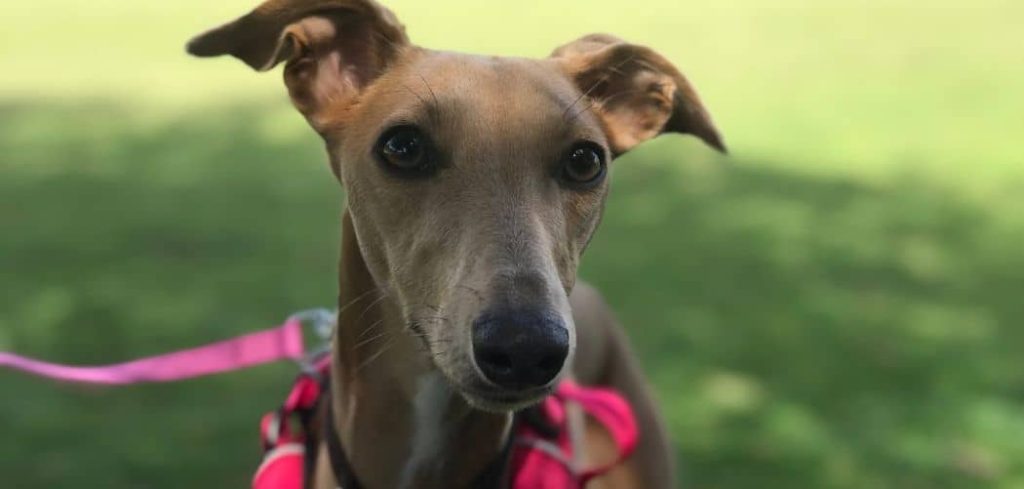A dog that is panting heavily while also biting or chewing its tail can leave owners worried and unsure about what is happening.
These symptoms may signal mild irritation, serious medical or behavioral issue that needs prompt attention.
We outline the common causes of a dog panting and biting its tail, what you can do at home, and when to seek veterinary help.
Dog Panting and Biting Tail — Why It Happens
A dog panting and biting it’s tail stems from a mix of physical discomfort, skin irritation, or emotional distress. Allergies, flea infestations, anal gland problems, and injuries can trigger these behaviors, as can pain from spinal or hip issues.
Stress, anxiety, or compulsive behaviors may also lead to both panting and excessive tail attention.

Dog Panting and Biting Tail: Common Causes
Fleas or Parasites
Fleas and other parasites can cause intense itching around the tail base and hindquarters.
A dog may bite or chew at its tail to relieve the irritation, while panting can result from the constant discomfort or secondary skin infections.
In severe infestations, your dog’s energy may be drained, and the stress of the itch-scratch cycle can lead to overheating and anxiety-related panting.
Even if fleas are not immediately visible, their presence can trigger significant distress.
Read more: Dog Excessively Biting Paws (Here’s why)
Allergies
Environmental or food allergies can cause skin inflammation, especially near the tail. The irritation leads to frequent biting, chewing, or licking of the area.
Panting may occur due to the discomfort itself or from increased body temperature if inflammation is widespread.
Allergies can also make your dog restless, pacing, or unable to settle comfortably, all of which contribute to heavier breathing. Seasonal changes or dietary triggers are common culprits.
Anal Gland Problems
Impacted or infected anal glands can cause pain and itching around the tail base.
Dogs may respond by biting or chewing the area in an attempt to relieve pressure.
Panting often accompanies this due to pain, discomfort when sitting, or stress from the constant urge to address the irritation.
Left untreated, anal gland infections can progress to abscesses, making early intervention important.
Pain or Injury
An injury to the tail, hips, or lower spine can lead to protective biting behavior.
Pain itself often triggers panting, as does the stress associated with trying to avoid movement that aggravates the injury.
You may notice stiffness, limping, or reluctance to be touched in certain areas along with the tail-biting and heavy breathing.
These cases often require veterinary evaluation to rule out fractures, nerve injury, or joint disease.
Anxiety or Compulsive Behavior
Stress or anxiety can lead some dogs to develop obsessive behaviors such as tail-chasing and biting.
Panting in these cases is often a sign of emotional arousal rather than physical exertion.
Changes in environment, loud noises, separation from owners, or boredom can all trigger this type of reaction.
Over time, compulsive tail-biting can cause open sores and infections, creating a cycle of physical and emotional discomfort.
Hot Spots or Skin Infections
Moist dermatitis, commonly known as “hot spots,” can develop quickly when a dog licks or bites at an area repeatedly.
The resulting wound can be intensely itchy and painful, prompting more chewing and panting from distress.
Hot spots around the tail area are especially irritating because the location makes them harder for the dog to leave alone.
Without treatment, the infection can spread rapidly.
What to Do If Your Dog Is Panting and It’s Biting Tail
Start by calmly inspecting your dog’s tail, hindquarters, and surrounding skin. Look for redness, swelling, fleas, or visible wounds.
If you find fleas or suspect parasites, begin treatment promptly using veterinarian-approved products.
Keep your dog’s environment cool and calm to reduce stress-related panting.
For suspected allergies, consider whether there have been recent changes in diet, bedding, or outdoor exposure that could be triggering symptoms.
Avoid letting your dog chew the area, as this can worsen injuries or infections.
Use an Elizabethan collar or recovery cone if needed until you can address the root cause.
Monitor for any signs of worsening condition, such as spreading redness, foul odor, or behavioral changes that suggest escalating discomfort.
When to Call or Visit Your Vet
Seek veterinary attention immediately if your dog’s panting is extreme, labored, or accompanied by lethargy, vomiting, or collapse.
Prompt care is also needed if you see signs of severe skin infection, swelling, pus, or if your dog appears to be in significant pain when sitting or defecating.
If the tail-biting has led to open wounds or bleeding, or if your dog’s behavior suddenly changes (becoming withdrawn, aggressive, or unusually restless), a professional evaluation is essential.
Read more: Dog Panting and Being Clingy (What it could mean)
Key Takeaway
Panting and biting the tail is a distressing combination of symptoms that can indicate anything from minor irritation to serious medical or behavioral problems.
Identifying the cause early is the best way to protect your dog’s comfort and prevent complications.
While some causes can be managed at home, persistent or severe cases should always be evaluated by a veterinarian.
Your attentiveness and prompt action can make all the difference in helping your dog feel better and get back to a happy, healthy routine.
